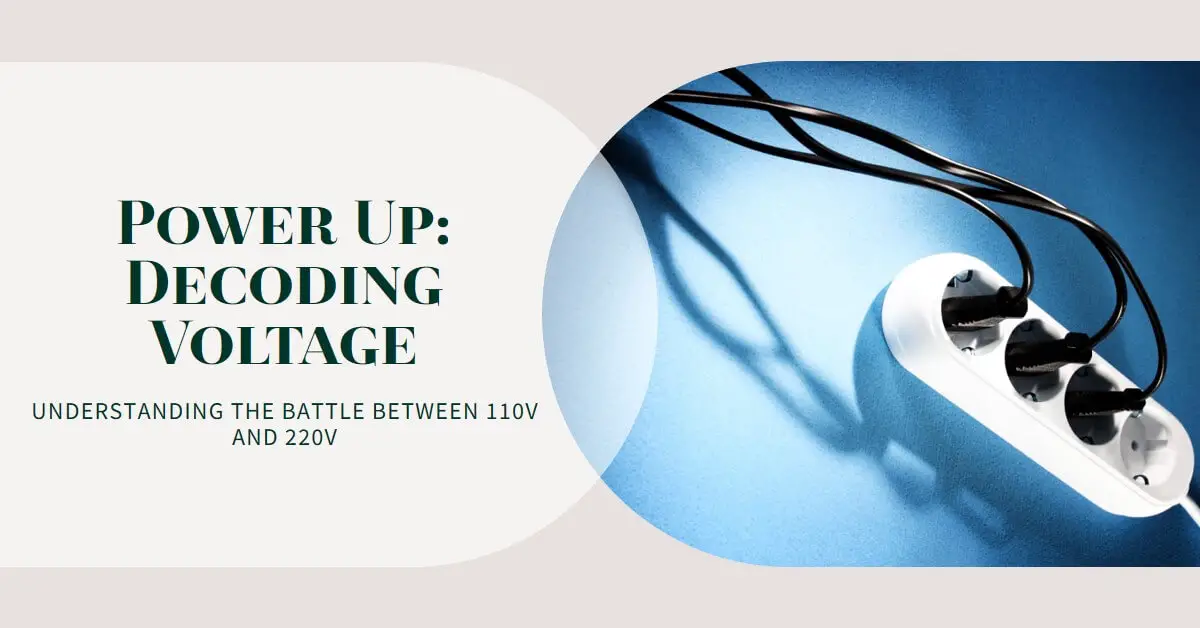Image: “Article Feature Image” by Bing, Source: [Bing Graphic Art].
The electrical voltage used in our homes and businesses plays a crucial role in powering our appliances and devices.
When it comes to voltage, the two common standards are 110V and 220V. In this article, we will explore the differences between these two voltages, examine their advantages and disadvantages, and help you understand which voltage might be better suited for your needs.
The better voltage option, whether 110V or 220V, depends on various factors such as regional standards, device compatibility, and personal requirements.
Understanding Voltage
Voltage is the electric potential difference between two points in an electrical circuit. It is measured in volts (V) and determines the amount of electrical energy that can be transmitted through a circuit.
Voltage is essential for the proper functioning of electrical devices and systems, as it provides the necessary power to operate them.
The Difference Between 110V and 220V
Voltage standards can vary from country to country, and the two most common standards are 110V and 220V.
In the United States, Canada, and some other countries, the standard voltage is 110V, while in many other parts of the world, including Europe, Asia, and Australia, the standard voltage is 220V.
The main difference between 110V and 220V is not the amount of power they can deliver, but rather the amount of current required to deliver a certain amount of power.
Both 110V and 220V power sources can indeed deliver the same amount of power. However, since power (measured in watts) is the product of voltage and current, the higher voltage of 220V allows for lower current requirements compared to 110V to achieve the same power output. For more information read my article Does a 220V Outlet Really Use More Electricity than a 110V Outlet?
In practical terms, this means that for a given power requirement, devices operating at 220V will draw less current than devices operating at 110V. This lower current demand may result in the need for smaller-sized wiring and protection devices such as breakers or fuses, which can lead to potential cost and efficiency advantages.
Electrical outlets and plug types also differ between 110V and 220V systems. In 110V systems, outlets typically have two vertical slots, while in 220V systems, outlets often have two round pins or other configurations.
It’s important to note that using incompatible plug types or voltages can result in damaged devices or safety hazards.
Read also my article: Is Your Device 110V or 220V? Here’s How to Find Out.
Advantages and Disadvantages of 110V
Advantages of 110V
One advantage of 110V systems is the wider availability of appliances and devices designed for this voltage.
In the United States, for example, most household appliances and electronics are designed to operate on 110V. This makes it easier and more convenient to find compatible devices for everyday use.
Another advantage is that 110V systems generally pose a lower risk of electrical shock. The lower voltage is considered safer, especially for children or individuals who might accidentally come into contact with electrical outlets or exposed wires.
Disadvantages of 110V
One limitation of 110V systems is their ability to handle power-hungry devices. High-powered appliances such as air conditioners, electric stoves, or heavy machinery may require more electrical current in the case of a 110V system than 220V.
This can lead to limitations in the types of devices you can use or result in reduced performance.
Additionally, 110V devices tend to consume more current compared to 220V systems. To power the same power rating device, a 110V system will require a higher current, which translates into increased wire and protection device sizing which in turn means a higher cost.
Advantages and Disadvantages of 220V
Advantages of 220V
One significant advantage of 220V systems is their ability to handle high-powered devices efficiently. Appliances like electric water heaters, electric vehicle chargers, or industrial equipment often require higher voltage to operate optimally. With a 220V system, you can power such devices without straining the electrical infrastructure.
Another benefit of 220V systems is their energy efficiency. Due to the higher voltage, 220V systems can deliver the same amount of power with a lower current compared to 110V systems. This reduces resistive losses in the wiring.
Disadvantages of 220V
A potential downside of 220V systems is the limited availability of appliances and devices designed for this voltage in regions that primarily use 110V.
If you reside in a country where 110V is the standard, finding compatible devices that operate on 220V may require additional effort and potentially higher costs.
Another consideration is the increased risk of electrical shock associated with 220V systems. The higher voltage can be more dangerous if proper safety precautions are not followed, and there is a greater chance of severe injury if an accident occurs.
Factors to Consider When Choosing Voltage
When deciding between 110V and 220V, several factors should be considered:
- Location and Electrical Infrastructure: The voltage standard in your country or region and the electrical infrastructure available in your building can influence your choice.
- Appliances and Devices: Consider the types of appliances and devices you use or plan to use. Determine their voltage requirements and availability for your desired voltage standard.
- Personal Preferences and Requirements: Assess your specific needs, energy efficiency goals, and safety concerns to make an informed decision.
Conversion and Compatibility
If you have a device designed for a different voltage standard, there are options for converting the voltage.
Voltage converters or transformers can be used to adapt the voltage to match the requirements of your devices. However, it’s essential to ensure compatibility and safety when using such converters.
Conclusion
In conclusion, choosing between 110V and 220V depends on various factors, including the region you are in, the devices you use, and your specific requirements.
While 110V systems offer wider device availability and lower electrical shock risks, 220V systems can handle high-powered devices more efficiently.
Consider these factors carefully to make the right decision for your electrical needs. Always prioritize safety and consult a professional electrician if you have any concerns or questions.
Want to learn more about electricity? Check my YouTube channel!
Are You An Electrical Engineer or Electrician?
Install my Free On Google Play Now! It’s 100% Free
The staff I recommend (Amazon Affiliate Links to products I believe are high quality):
- Economy 120 Volt/60Hz AC Power Source – Step-Down Voltage & Frequency Converters 1800W
- UNI-T Digital Multimeter Tester UT139C
- 50-Amp Extension Cord for RV “100ft”
- Voltage Stabilizer 110/220v
- Hair Dryer “best selling“
- TOSHIBA EM131A5C-BS Countertop Microwave Ovens
Disclaimer: This contains affiliate links to Amazon products. I may earn a commission for purchases made through these links.


